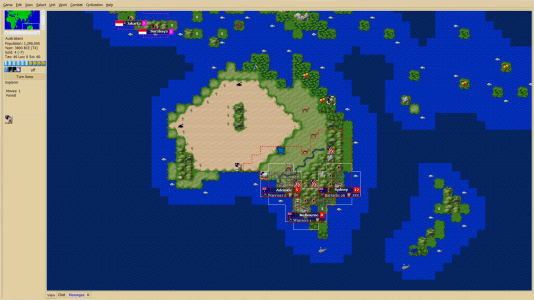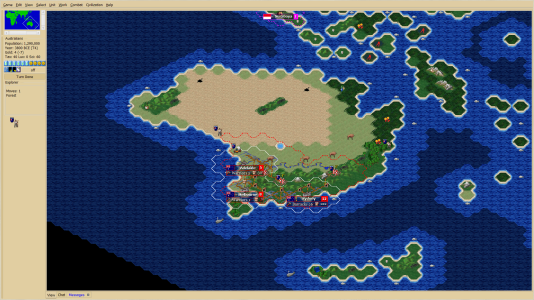For hexes, what you'd do I think is just create a whole new renderer. And reuse some components like city billboards and symbols.
It is something I've wondered about. Take the hexes from modern civ and just force civ 4 onto a hex grid. But, not very easy. Maybe you'd need new map scripts. But at least, a lot of things in the DLL appear to be grid-agnostic.
Could probably do it with graphical civ 4 too. The art assets weren't made for it, but it could work.
Interesting...
What do you think about SMAC-like dynamic voxel squares? Would they be possible?
Yeah, but SMAC's turns represent weeks or months, not decades, rigth?
Every turn is an year, actually. Pretty sure that can be changed in a scenario, through.
How is it in Paradox games? And could those be used in Civ4, if possible at all?
Probably couldn't be used in Civilization IV. Perhaps in a new engine.
Essentially, most paradox games use a system which divides land into two categories:
Owned/Controlled. Owned Land belongs to a certain nation X, Controlled Land is land currently controlled by any nation, be it X or someone else. Usually, most nations both Own and Control a province, but when things like war happen, you can have a situation where one nation owns the province and another controls it. So for example, if during a war, an enemy force takes your province, it is controlled by that enemy, but you still own it. You can only transfer land ownership through a peace treaty, and if I recall it right, controlling but not owning doesn't give full advantages for having the land.
Compare this to Civilization, where owned = controlled City.
Paradox Games also have the concept of Core territories, in which a nation may have Cores in certain provinces, which are provinces it (or the world community) recognizes as possibly theirs. In some games, you can "create" cores or claims which legitimate conquest through casus belli.
Paradox games also often use the concept of Casus Belli, in which wars often require a cause to pursue - say, obtaining certain core provinces, forcing a Personal Union between two kingdoms, etc. In some games you can do no-CB wars, but that's usually punished somehow. In other games, certain groups (Pirates, Steppe Raiders, etc) have pretty much free CBs to raise hell.
Paradox games also often have deeper diplomatic relationships. Like, Civilization mostly tends towards Peace/Alliance/War. Paradox games have things like Vassalization/Puppets, Tributaries, Protectorates, etc. Depends on the game.
Some paradox games, like Crusader Kings games, also have non-Westphalian states.
Care to explain? I'm always looking for ideas for my mod what to add/improve/implement, if I can

Man, there's a lot. Top of my head:
Call to Power:
- Public Works (no workers to build tile improvements, tile improvements are built with the public works resource)
- Space Map
- Space and Undersea Colonies
SMAC:
- Unit designer (yeah yeah polemical feature I know)
- Dynamic Voxel Map - SMAC doesn't have "static terrain tiles", like, there's no such thing as a "grassland tile". Rather, every tile has dynamic values like Rockiness (which determines mineral production potential), Rainfall (which determines how much Nutrients it produces) and Altitude (which determine how much energy can be produced there, but can also determine the Rainfall of a tile if its East or West of a mountain range). All these values can be altered through terraforming and gameplay. This allows A LOT of terraforming that simply isn't seen in a civilization game, ever. You can make terrain higher or low, you can create more land and sink it, you can make a place more or less rainy, you can dig aquifers and create new rivers, etc. The way SMAC does terrain is absolutely vanguardist and is so beyond pretty much all civilization games and its clones, its not even funny.
- Social Engineering. Civilization IV picked it up but I feel like it didn't do as well.
Space Empires IV:
- Actually having to supply your ships
- Satellites and space bases
- Incredible levels of ship, space base and satellite customization
 <= square vs hex =>
<= square vs hex =>








